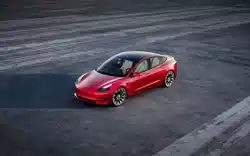Loading ...
Loading ...
Loading ...

For more information on troubleshooting Mobile
Connector or Wall Connector status lights, refer to the
product's Owner's Manual at Charging & Adapter
Product Guides. If using other external charging
equipment, refer to the manufacturer's provided
documentation for troubleshooting tips.
(CP_a054)
Charge port latch not engaged
Fully insert charge cable or check
for obstruction
The charge port latch is unable to latch the charge cable
in the charge port inlet. If the latch is not engaged, AC
charging (for example, charging with a Tesla Mobile
Connector or Wall Connector) will be limited to 16A and
DC Fast Charging / Supercharging will be unavailable.
The charge port light will pulse amber if this alert
appears during AC charging and will be solid amber if
this alert appears when attempting to DC Fast Charge /
Supercharge.
Try re-inserting the charge cable fully into the charge
port inlet.
•
If the vehicle begins charging and the charge port
light pulses green, the charge cable may not have
been fully inserted. The latch may not have engaged
during previous attempts, because the cable was not
fully inserted, even though it may have appeared to
be. AC charging should no longer be limited and DC
Fast Charging / Supercharging should be possible.
•
If charging is still limited or the vehicle does NOT
charge, inspect the charge port inlet and the charge
cable connector for any obstructions (use
flashlight
as necessary). Debris, and/or foreign objects present
in the charge port inlet or the charge cable connector
can prevent the charge cable from being fully
inserted and the charge port latch from engaging. If
any obstruction is found:
1.
Remove the debris / foreign object.
2.
Try re-inserting the cable into the inlet. AC
charging should no longer be limited and DC Fast
Charging / Supercharging should be possible.
As this alert is usually specific to external charging
equipment and power sources, and it does not typically
indicate an issue with your vehicle that can be resolved
by scheduling service, it is recommended that you:
• Make sure the charge cable is fully inserted during
charging.
•
Make sure any charge port inlet obstruction has been
removed.
You can also try charging your vehicle using a Tesla
Supercharger or Destination Charging location, all of
which can be located through the map on your vehicle's
touchscreen display. See Range Assurance on page 72
for more details. Additional third-party charging stations
may also be available in your area to help you to
pinpoint the issue.
For more information on troubleshooting Mobile
Connector or Wall Connector status lights, refer to the
product's Owner's Manual at Charging & Adapter
Product Guides. If using other external charging
equipment, refer to the manufacturer's provided
documentation for troubleshooting tips.
For more information on charging, see Charging
Instructions on page 156.
(CP_a055)
Charging equipment
communication lost
Check power source and charging
equipment
Charging stopped because communication between the
vehicle and the external charging equipment was
interrupted.
Confirm whether the external charging equipment is
powered by looking for any status lights, displays, or
other indicators on the equipment.
If the equipment is not powered, try to restore the
external charging equipment’s power source.
•
If attempting to charge at a public station and power
is unable to be restored, contact the station operator.
•
If attempting to charge at a private station (for
example: charging at home) and power is unable to
be restored, contact an electrician.
If the equipment is powered, try charging the vehicle
using dierent external charging equipment.
•
If the vehicle begins charging, the issue was likely
with the equipment.
• If the vehicle still does not charge, the issue may be
with the vehicle.
As this alert is usually specific to external charging
equipment and power sources, and it does not typically
indicate an issue with your vehicle that can be resolved
by scheduling service, it is recommended that you:
• Make sure the external charging equipment is
powered.
•
Try charging with multiple, dierent types of
charging equipment.
Troubleshooting Alerts
217Consumer Information
Loading ...
Loading ...
Loading ...
